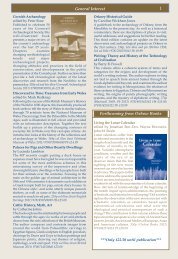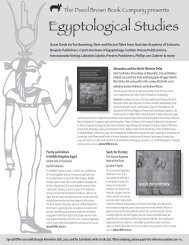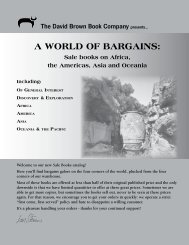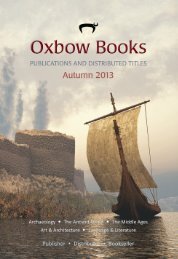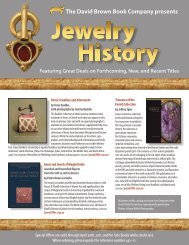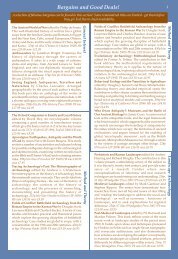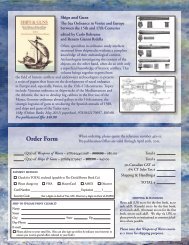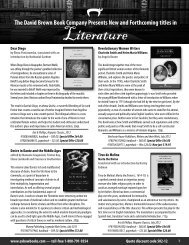Oxbow Spring 2013.pdf - Oxbow Books
Oxbow Spring 2013.pdf - Oxbow Books
Oxbow Spring 2013.pdf - Oxbow Books
You also want an ePaper? Increase the reach of your titles
YUMPU automatically turns print PDFs into web optimized ePapers that Google loves.
Veii. The Historical Topography of the Ancient City<br />
A Restudy of John Ward-Perkins’s Survey<br />
Roberta Cascina (Editor); Helga Di Giuseppe (Editor); Helen Patterson (Editor)<br />
During the nineteenth century, antiquarians such as William Gell and George<br />
Dennis visited the ancient city of Veii, some 15 km north of Rome, and noted the<br />
rapid destruction of its archaeology. The city continued under to be under threat,<br />
and in the 1950s was the subject of ground-breaking survey and excavation by<br />
John Ward-Perkins. However, the results of his fieldwork were never published<br />
fully. Knowledge and understanding of material culture (especially pottery, votive<br />
objects and architectural terracottas) has increased dramatically over the past<br />
fifty years, so allowing the authors to reveal the full potential of the data. This<br />
publication reaffirms many of Ward-Perkins’s original insights, and contextualizes<br />
his research within the new discoveries of the past fifty years; whilst an important<br />
contribution to our knowledge, it is also a spur to further work.<br />
9780904152630, £85.00, February 2013, HB, 432p, 142 illus, 2 colour plates<br />
Archaeological Monographs of the British School at Rome 19, British School at Rome<br />
Vesuvian Sigillata at Pompeii<br />
Jaye McKenzie-Clark (Author)<br />
The destruction of Pompeii in AD79 provides a unique opportunity to explore the<br />
use of everyday items. It allows us to identify the source and variety of products<br />
available within the city, and enables us to track changes in the consumption of<br />
goods over time. In this volume, Jaye McKenzie-Clark presents the far-reaching<br />
results of her examination of the red slip tableware within three regions of the city.<br />
It pinpoints the initial supply and use of Vesuvian Sigillata, and investigates factors<br />
that may have led to the popularity of this style of pottery. The investigation<br />
maps the on-going manufacture of these ceramics and identifies changes in<br />
production and consumption up to the time of the eruption. Examination of the<br />
distribution within contexts of different social use also reveals distinct patterns<br />
of consumer demands and consumption within Pompeian society. Such research<br />
helps us to explore and understand the use of goods within the city of Pompeii<br />
and throughout the Roman world.<br />
Classical World – Ancient Rome<br />
9780904152623, £19.95, February 2013, PB, 162p, 32 illus, 4 colour plates<br />
Archaeological Monographs of the British School at Rome 20, British School at Rome<br />
Rome, Portus and the Mediterranean<br />
Simon Keay (Editor)<br />
One of the greatest consequences of Rome’s expansion across the Mediterranean<br />
world in the course of the Republic and the earliest years of the Empire was an<br />
exponential growth in the population and extent of the city itself. The emperors of<br />
the first three centuries ad faced major strategic challenges in ensuring a regular<br />
annual supply of food to the city, as well as other goods. This volume brings together<br />
various contributions, to assess how far Portus, as the maritime port of Imperial<br />
Rome from the mid-first century ad, was the principal conduit for supplying Rome<br />
and the extent to which the commercial links that fed Portus were part of a single<br />
overarching network or a series of interlinked networks that extended across the<br />
Mediterranean. The volume begins with a detailed reconsideration of Portus and<br />
its relationship to Ostia and Rome, continuing with studies that deal with a range<br />
of broader issues concerning the relationship of Mediterranean ports to Rome,<br />
Portus and Ostia before returning to more general considerations of connectivity,<br />
networks, coastal geo-archaeology and computational methods.<br />
9780904152654, £90.00, February 2013, HB, 454p, 158 illus, 14 colour plates,<br />
Archaeological Monographs of the British School at Rome 21, British School at Rome<br />
27




